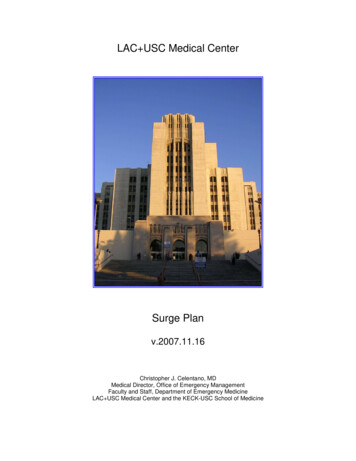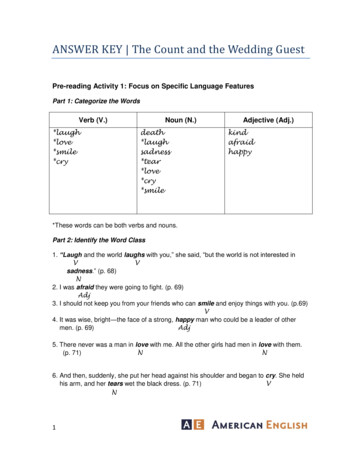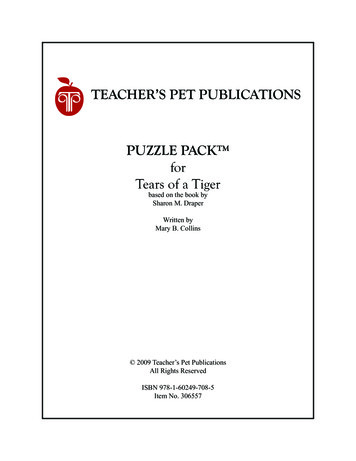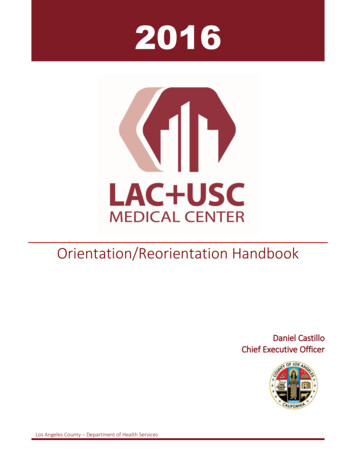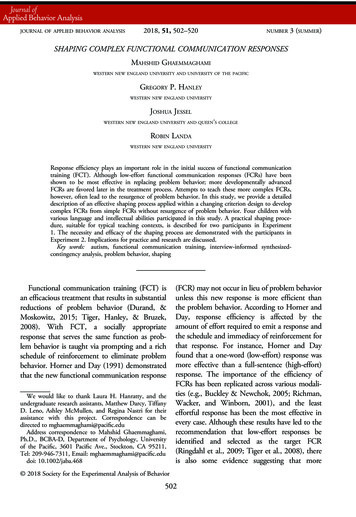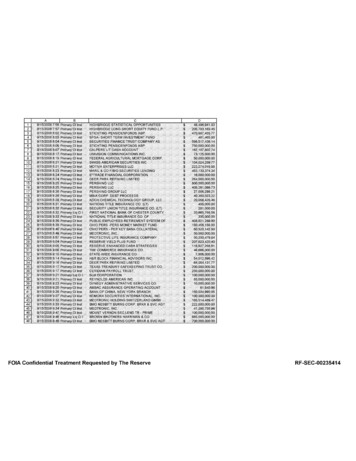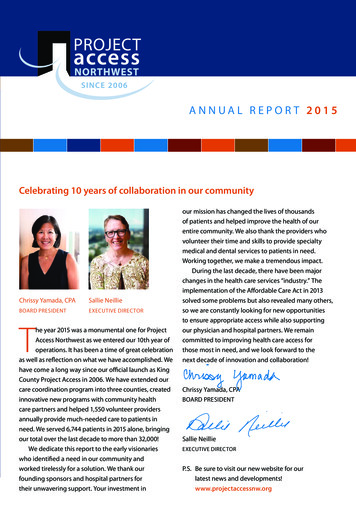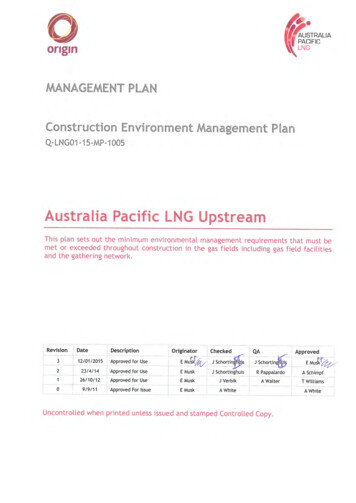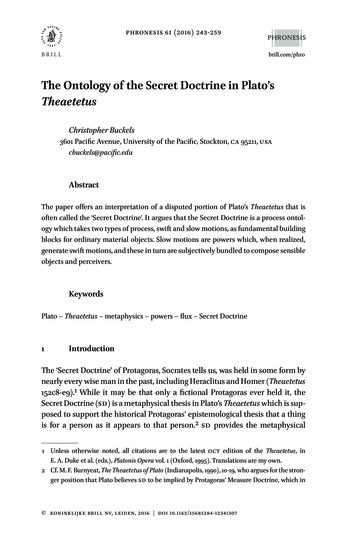
Transcription
Chinese Medical OphthalmologyAndy Rosenfarb, ND LAc
Dr. Rosenfarb’s Published Books
Coming Soon!
Retinitis Pigmentosa Research JohnsHopkins University, Maryland - 2012 NOVA Southeastern University - 2014
Appearance onThe Dr.Oz Show
Clinical ObjectiveTo IMPROVE and RECOVER lost vision.&PRESERVE vision LONG TERM!
Vision & The Eye The Eye contains more than 50% of the totalsensory receptors in the body. The Eye - 2.5 cm diameter Anterior eye is only 1/6 of the eye Vision is the Interplay of Matter & Energy Material/Structure (Eye Structure-Yin) Immaterial/Function (Vision-Yang)
Anatomy of the Eye Three coats or tunics Fibrous: Consists of sclera and cornea Vascular: Consists of choroid, ciliary body, iris Nervous: Consists of retina15-9
How the Eye Works The eye functions like a camera Iris allows light into eye Light striking retina is converted into actionpotentials (images) relayed to brain forinterpretation.Lens, cornea, humors focus light onto retina15-10
How We See
15-12
What Causes of Failing Vision? Genetic PredispositionTrauma/ Injury/ IllnessDrugs/MedicationsMetabolic ImbalancesPoor NutritionEye StrainEpigenetic Stress FactorsPoor CirculationSystemic Disease
Conventional Medicine The eye is diagnosed and treated as anisolated organ pathology. Decline of vision is said to bea “natural process,” that caneither stabilize or get worse.
Conventional Approaches forEye Disease “Corrective” Glasses & Contacts Lenses Medications Surgical Procedures “Wait and See What Happens ”
Chinese Medicine Approach Deals with the body as a whole,rather than in individual “parts.” Everything is “connected,” and visioncan be influenced by all organs in the body. According to Chinese Medicine,most eye disease is related toLiver (functional) and/orKidney (structural) dysfunction. Holistic-Integrative approach producesthe best outcomes for our patients.
How Acupuncture Helps VisionIncreases Blood Flow the eye (O2 food) Stimulates Nerve Cells Charges Dormant Retinal Cells Regulates the Autonomic NervousSystem Promotes a Parasympathetic Response Treats BOTH eye condition & underlyingcause
Primary Objectives forPreserving VisionImprove Circulation Stimulate Photoreceptors, OpticNerve & Visual Cortex Decrease Inflammation Reduce Oxidative Stress Identify & Manage Causative Factors Long term Neuro-Protection
CHINESE MEDICINE &DEGENERATIVE VISION LOSS
TCM 5-Wheel TheoryElementYin OrganYang OrganStructureFireHeartSm. dsaqueousMetalLungLg. IntestineSclera cornea,conjunctivaWaterKidneyUrinaryBladderPupil, macula,& retina,choroidWoodLiverGall BladderIris & eyemuscles
Eyes & The LiverLiver Opens into the Eyes, eyes reflectthe function of the liver. Liver Qi is connected to the Eye & theHarmony of the Liver Qi allows the Eyesto see. Liver stores the blood; the storage ofblood allows the eyes to see. The Liver governs the tears; the tearsluster the eyes.
Eyes & The HeartThe Heart Governs the Blood, the bloodnourishes the eyes. The Heart s connected with the bloodvessels, and all the vessels are relatedto the eyes. The Heart houses the spirit andliveliness; the eyes command the Heart.
Eyes & The SpleenThe Spleen Transports Essence upwardto the eyes. The Spring brings clear yang upwards tothe eyes. The Spleen Qi controls the blood tocirculate within the blood vessels of theeyes.
Eyes & The LungThe Lung Dominates Qi; the harmony ofQi ensures the brightness of the eyes. The Lung governs dispersing anddescending; the smooth flow of Wei Qito the collaterals of the eye. Lungs Govern the exterior, protectingthe eyes so as to be nourished andwarmed without damage by externalpathogen
Eyes & The KidneyKidney Governs the storage of Essence;sufficiency of Essence ensures the brightnessof the eyes. Kidney engenders the cerebral marrow; theeyes are connected with the brain. The kidney governs fluids & moisten the eye. The Kidney supplies True Yin and True Yang; itnourishes and supports the function of theretina, pupil, chorroid, aqueous & vitreous.
Relationship with the Six Fu Zang moves Qi to the Fu; Fu TransportsEssence to the Zang. Six Fu: govern reception, control digestion,separate clear and turbid, move wastethrough the bowels, transport essence inthe form of “Sensory Jing” to the eyes. In short, Fu delivers Ying-Nourishmentthe eyes to maintain healthy vision.
TCM Pathogens & Eye DiseasesPATHOGENORGANEFFECT ON EYESFire/HeatHeartSwelling, redness,inflammationColdKidneySlow onsetdegenerative eyediseasesWindLiverSudden onset eyediseasesDampnessSpleenMucus, edema,secretions – slowonsetDrynessLungDryness, itching,rednessSummer HeatAll OrgansInflammation w/mucus
EYE CONTITIONS
Macular Degeneration
AGE RELATED MACULAR DEGENERATIONInsufficient oxygen and nutrientsdamages photoreceptor moleculesWith ageing, the ability of RPE cells to digest thesemolecules decreasesExcessive accumulation of residual bodies (drusen)RPE membrane and cells degenerate and atrophy sets inand central vision is lostBMJ 326, 2003; 485-488
AGE RELATED MACULAR DEGENERATIONAlternatively the photoreceptors and pigment epithelium send a distresssignal to choroid capillaries to make new vesselsNew vessels grow behind the maculaBreakdown in the Bruch’s membraneBlood vessels are fragileLeak blood and fluidScarring of maculaPotential for rapid severe damageBM J 326; 2003: 485-488
DRY MACULAR DEGENERATION1.Accounts for about 90% of all cases1.Also called atrophic, non exudative ordrusenoid macular degeneration
DRY MACULAR DEGENERATIONDrusen Drusen is an aggregation of hyaline material locatedbetween Bruch’s membrane and RPE. Drusen are composed of waste products fromphotoreceptors. Drusen 63 microns in diameter are statistically associatedwith visual pathology and are termed early ARMD. Hypo/hyper pigmentation of RPE may be presentNEJM, Vol 342 (7): 483-492
DRY MACULAR DEGENERATION: VISUAL
WET MACULAR DEGENERATION Accounts for about 10%Also called choroidal neovascularization,subretinal neovascularization or disciformdegenerationAbnormal blood vessels grow beneath themaculaThese vessels leak blood and fluid into themacula damaging photo receptorsProgresses rapidly and can cause severedamage to central visionhttp://www.blindness.org
Treatment Guidelines for AMD Acupoints: Sp-3, Ht-8 Qihou, GB-20, Yuyao, St-2, UB-2, Sp-6, St-36, GB-37, Lv-2 Bleeding – Moxa Sp-1 TC Herb Rx: San Ren Tang Phlegm-DampXiao Yao San – Qi StagnationZhu Jung Wan – Lv/Ki DeficientMing Mu Di Huang Wan – Lv/Ki deficient
Retinitis Pigmentosa
What is Retinitis Pigmentosa? Retinitis Pigmentosa, also known as RP, is a group of diseases thatusually run in families which causes slow, but progressive andpermanent loss of vision. The retina is a tissue which lines the inside of the eye, and sendsimages to the brain. RP causes a gradual destruction of the lightsensing cells, dark and peripheral vision cells, straight ahead and finedetails, and cells responsible for seeing color. Currently there is no cure for Retinitis Pigmentosa, however there aredevelopments progressing.
Causes Retinitis Pigmentosa (RP) is a group of inherited diseases thatdamage the light-sensitive rods and cones located in the retina,the back part of our eyes. Rods, which provide peripheral and night vision are affectedmore than the cones that provide color and clear central vision.
The RP Eye:Left: Normal EyeRight: RP Eye
Healthy Retina vs. Affected Retina
Through the Eyes of RPTunnel Vision
Frequency Internationally: The incidence of primary RP isapproximately 1 in 4000. Gender: Because of X-linked varieties, men may be affectedslightly more than women. Age: The age of onset varies depending on the disorder. RPusually is diagnosed in young adulthood, although it canoccur anywhere from infancy to mid 30s to 50s.
Treatment Guidelines for RP Main TCM DX: Liver Blood Stasis with lungDeficiency Acupoints: Lv-8, Ki-10, Ki-7, Sp-3, Ht-8, Lu10, Taiyang, Yuyao, UB-2, St-1 Herbs: Xue Fu Zhu Yu Tang – blood stasis Qi Ju Di Huang Tang – Li/Ki Yin Shi Hu Ye Guang Wan – Night Vision/ Yin Def
Glaucoma
Types of Glaucoma Congenital, Trauma, Steroid InducedNormal Tension GlaucomaOpen Angle Glaucoma (Chronic)Closed Angle Glaucoma (Acute) HeadachesNo SymptomsEye PainNauseaSeverely Blurred Vision
Glaucoma DiagnosisThese are four things Ophthalmologist’slook for: The eye’s fluid pressure The shape and color of the optic nerve The complete field of vision The angle where the iris meets the cornea
Eye’s Drainage System
Focus Tx on The Optic Nerve
TCM Pattern Differentiation forGlaucoma Open Angle (Chronic) Kidney Deficiency Liver Deficiency Liver Qi & Blood Stagnation Stagnation of Fluids Closed Angle (Acute) Liver Wind Stirring/ Liver Yang Rising
Treatment Principles1.Warm & Strengthen the Yang (and Qi)1. Jin Qui Shen Qi Wan2. Wen Dan Tang3. You Gui Wan2.Move the Qi & Blood (and fluids)1. Dai Di Dang Wan – stagnation of essence2. Xue Fu Zhu Yu Tang3. Xiao Yao San
TCM Acupuncture Focus on the GB Xu & UB to being Ying to Eyes to enableYang Stagnation of Qi, Blood, fluids & Deficiency of Jing Locate ah-shi points on these meridians. Common pointsused: SJ-3, LI-4, GB-4,20, 43, 37 Taiyang, UB-1,2, 62, SI-3,K-7 DO NOT USE LOCAL E-STIM FOR GLAUCOMA PATTIENSAS IT CAN RAISE Inter-Ocular Pressure!
Andy’s Acupuncture GlaucomaGuidelinesTreatment:GB-1 (local), GB- 20 (move Qi to the eyes), GB-30 (move Qi in GB),GB-37 (special eye point), GB-43 (tonification), UB-2 (local),St-2 (local), St-36 (horray), Lv-8 (move blood), Ki-7 (tonify yang qi)Extra Glaucoma points: Extra Glaucoma #1 – 1 cun superior to SJ-23; and one finger-widthlateral. In the tender spot, needle posterior until a strong “de-Qi”sensation is obtained. Extra Glaucoma #2 – ½ cun anterior to St-5; needle superior intender area as to obtain a strong “de-Qi” sensation.Eye Exercises to Reduce IOP – Press & Hold St-1 3x for 10 secondsDirect Moxa: Knuckle of second joint of thumb & middle finger
Supplements for Glaucoma Cod Liver OilVitamin CTaurineColeus Forskohlii (Steaming)Ginko BilobaTurmeric & Circumen
Cataracts
What is a cataract? A cataract is a clouding of the lens inthe eye that affects vision. Mostcataracts are related to aging. Cataractsare very common in older people. Byage 80, more than half of all Americanseither have a cataract or have hadcataract surgery. A cataract can occur in either or botheyes. It cannot spread from one eye tothe other.
Cataracts
TCM Diagnosis &Treatment of Cataracts
TCM Herbs for Cataracts Kidney & Lung Yin Def. Qi Ju Di Huang Wan Sha Shen Mai men Dong Tang (Glehnia &Ophiopogon) Internal Heat/ Fluid Deficiency Qi ju Do Haung Wan Gou Qi Zi & Ju Hua Qi & Blood Yu Xue Fu Zhu Yu Tang
TCM Acupuncture for Cataracts Focus on LI, St and UB to bring Ying to theEyes. Taiyang, St-1 UB-2, Lu-10, Lu-7, K-3 & 6,LI-1 Use herbs, diet, fluids, & supplements tohydrate & nourish Yin. Need to cool,moisten, & hydrate.NOTE: Looks for possible infections orchronic GI inflammation other than cardiostress.
Supplements for Cataracts Vitamin C & BioflavonoidGlutathione (antioxidant)Alpha Lipoic AcidNAC Eye Drops, “CAN-C”Smoking is the WORST thing for cataracts!
What Can Effect the Outcome? How advanced the condition isDegree of emotional stressOther co-existing conditionsWillingness to receive treatmentCompliance with treatment andsupplementsSleep and Adequate Rest during recoverySmoking, Alcohol, Drugs (Rx and Non-Rx)Poor Diet & Malnutrition
THANK YOU!
Shi Hu Ye Guang Wan
